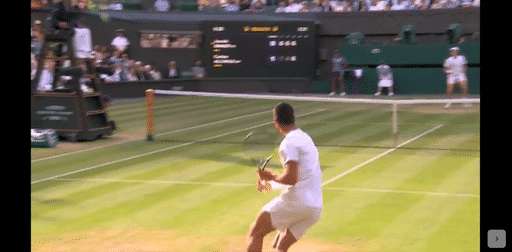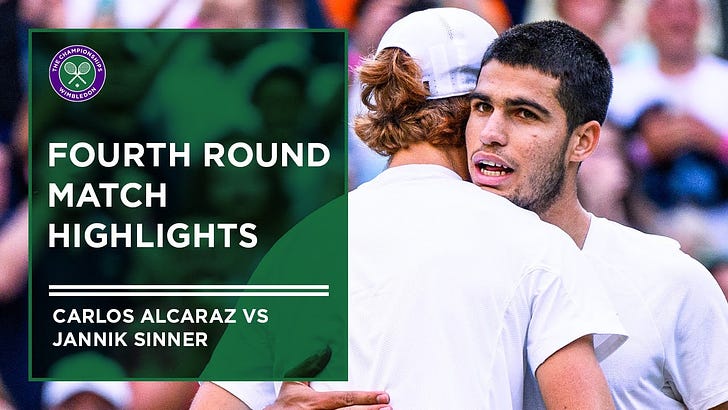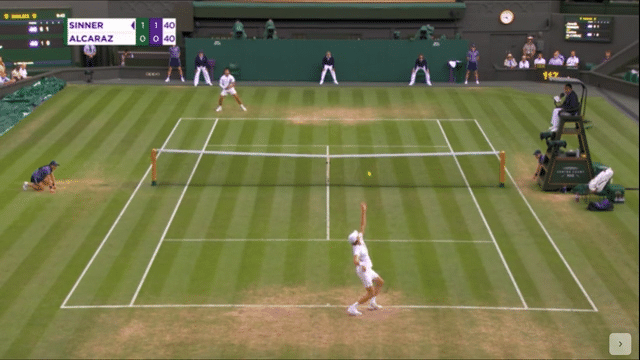Sinner and Alcaraz: Chasing Control
Alcaraz v Sinner—Nadal v Djokovic—margins of errors—via negativa
Jannik Sinner defeated Carlos Alcaraz 6/1 6/4 6/7 6/4 in a fourth-round clash at Wimbledon earlier this month that may be a glimpse of two future number 1s.
I have written about Sinner’s technical proficiency off both groundstroke wings here. In a nutshell, Sinner hits technical markers on his forehand and backhand that few others do, and it should be no surprise to see him high on return stats leaderboards for as long as he plays tennis (and the rankings in general). Recently, his serve has improved with the change to a platform stance and a delayed racquet head in the takeback, and I think his game is ready to challenge for majors. His win over Alcaraz and subsequent five-set loss to Djokovic in the quarterfinals has the young Italian firmly developing into an entrenched top-5 player, and many are noting style similarities between himself and the Serb.
I have also written about Alcaraz and his game here. Alcaraz has similar technical markers that he hits across the forehand and backhand, and it has been hard not to make comparisons with the Big-3 as he chases down some of their teen records.
Both youngsters play with huge power and aggression off the ground. However, over five sets the controlled aggression of Nadal, Djokovic, and Medvedev—the three players who have dominated most majors in recent years—has won out over bigger hitters. Former world number 3, Nikolay Davydenko, also noted this:
“In my opinion, tennis is not making much progress. The players who are at the top now – not Nadal and Djokovic, but the younger generation –are not that good technically. I got surprised by that. It’s more physical – big serves, hitting hard–, but we still see that Nadal and Djokovic can control all this power over the new generation. They are still winning Slams and beating guys who are ten years younger than them, which is amazing. Anyway, I do not feel that the new generation is playing on an unbelievable level.”
We have seen the Big-3 change their serves and forehands over the course of their careers, tweaking swing lengths and styles, and adapting with age to remain atop the game, but their groundstrokes were always of the same kind, with the changes made only differing the stroke by degrees. I think youngsters like Alcaraz and Sinner—as good as they are—can make technical improvements in their own games to help reach the summit of the sport.
The Forehand
I have touched on Alcaraz’s forehand in past analyses. An excerpt from that piece:
“As much as I love the Alcaraz forehand, his initial set-up with an inverted racquet head and high elbow mean he needs time to unload. It means the swing is a little ‘noisy’. It’s reminiscent of Thiem’s forehand when he first came on tour, and I think long-term drifting toward a lower elbow/modern forehand like Thiem did (and which subsequently allowed him to start winning on all surfaces against the Big-3) might make it even better. See Death of a Forehand Part I for more on this as well as the video below.”
In their fourth-round clash Sinner exposed Alcaraz’s long swing with his early and powerful returns. Early in their match, with Sinner ahead 4-1, Lleyton Hewitt made this remark following another of these rushed forehands shown below:

Hewitt: “He’s just got to be a little bit sharper after his serve to be ready to fight that first shot off. It’s so important on the quicker courts. Even abbreviate the swing a little bit, don’t take such a big swing at that next shot.”
Here is another return focused on Sinner

When you start a swing with the elbow high and racquet head inverted, it’s hard to shorten the swing. The racquet must travel through more space up to contact, and that takes more time (all things being equal1). The thumbnail of the video below comparing Alcaraz’s forehand set-up against a mirrored version of Fernando Verdasco’s shows this difference. Of the numerous matches I have done involving Alcaraz, by far his biggest source of errors is when he is moving to the forehand side.2 This may be just fine for clay and slower or bouncier courts, but I think dropping the elbow can help Alcaraz adapt to faster conditions.
This is exactly what Thiem changed in 2019, and allowed him to become a hardcourt threat as I wrote about here. Below is a gif from that piece highlighting the early forehands that were made possible with a lower elbow and shorter swing.

This point below between Berrettini and Thiem showcase their forehands. On the way back in the unit turn both: 1) keep the racquet tip above their hands 2) the elbow below the shoulder 3) the racquet on the hitting side of the body. This allows them to handle each other’s pace and take the ball early (and still murder the ball).
Here is Sinner handling a fast return from inside the baseline.
Although Sinner keeps his elbow lower (like Thiem) and allows him to take the ball earlier than Alcaraz, he does what a lot of players have adopted recently and keeps the tip pointing more to the outside (the racquet head is the same height as his hand, rather than having the racquet head above the hands as Djokovic and Thiem do). This is still a short swing, but it increases lag. Here is Sinner’s forehand compared to Djokovic’s.
As the video states ~1:55 Novak’s more upright racquet head means he is tapping into gravity to generate that initial racquet head speed. It’s a great source of power; effortless and consistent. Sinner generates that initial speed by using the racquet head to whip around from the side of his body. What’s the difference? Like the video says, the Sinner/lag forehand “can be harder to manage, especially if you’re having an off day. Djokovic’s is a simpler type of swing…Sinner has more of a correction to get the butt of the racquet facing the ball. With Djokovic, there’s less to calculate here. There is less to undo.”
Once again, Novak came through that encounter, as Sinner’s level dropped from his super-high form in sets one and two, and Djokovic’s consistency and depth won out in the fifth set. The greats tend to find good tennis when they need it the most. I think this is partly reflected in their technique being simple (yes, I do think their mentality is special and I will touch on that in next week’s post). In fact, when commentators say of player x “he’s feeling it now,” perhaps in reference to a patch of play where he can’t miss a particular shot, what is really happening is that the player’s pre-impact is dialed in. It’s a misnomer, as Duane’s Biomechanical Principles of Tennis Technique mention:
“When tennis players say they admire another player’s great “feel” they are likely admiring his pre-impact racquet control that manifests itself in precisely adjusted ball speed and spin off the racquet.”
With nearly any decent technique you will—for a patch—find the groove and time the ball sweetly. The goal is to make that patch as easy to find as possible. You could argue early on Djokovic’s forehand was too big in the backswing, but like Thiem, the fundamentals were good, and he shortened it while maintaining an upright racquet head. He made his forehand patch easier to find. Here is Djokovic’s forehand from 07/08. Note the higher elbow, more inverted racquet head, and longer take-back (almost behind his body):
Federer’s forehand from his heydey years in the 2000s was closer to Djokovic’s and Thiem’s current forehands in terms of their gravity-assisted swing path with the racquet tip above the hands.3
Compare that to how Federer has been hitting his forehand in recent years by using more lag with the racquet tip lower to the side fence, and is compared alongside the ultra-whippy forehand of Jack Sock.
In my opinion, Federer’s forehand was more potent and consistent when he was using gravity-assisted mechanics during the mid 2000s.
To be clear, I am not saying that the lagged forehands of Sock, or the higher elbow of Alcaraz, or any other top player’s technique are wrong, I’m asking the question if there is a better way by looking at what tends to appear in the great forehands of slam winners. I believe the ideal mechanics of the forehand have not changed4, and although we see numerous players using the lagged forehand typical of youngsters today (including Federer now) I still contend the best forehands are hit with gravity-assisted mechanics, and that players like Sinner (by getting the racquet head more upright) and Alcaraz (by lowering the elbow) could look to tweak their forehands in line with this to improve their consistency and ability to time the ball. Of all the youngsters coming through, it has never been an issue of spin and power. Many people talk of a shot having a higher “margin of safety” (height over the net) because it has more spin, but fail to recognise that it has usually come at the expense of a noisier swing; the swing has less margin for error in timing the ball. Medvedev has very little spin on his groundstrokes, but is extremely consistent because his strokes have high margins technically. These are nit-picky one-percenters, but one percent at this level is a huge difference.
The Backhand
The backhands of Sinner and Alcaraz differ in two important ways: the set up with the hands, and the drop. While Sinner drops his racquet head below the ball and from the inside very well, Alcaraz’s backhand does not. Like some of the nextgen forehands that rely on racquet lag with a pre-stretch in the arm and wrist muscles, Alcaraz does this on the backhand side. There are a lot of similarities in the backhands of Sinner and Djokovic, so the below comparison between Djokovic and Alcaraz provides a great explanation for why I think Alcaraz will always be susceptible on his backhand wing day-in and day-out. It’s not as clean and he doesn’t generate as much spin or get the outside of the ball effectively.
Can Alcaraz handle that technique and still have a great backhand and great career? Absolutely. He’s a world-class athlete and generational talent who is already breaking records. But will it approach Djokovic’s in terms of quality? No. The eye of the needle he must thread shot-after-shot is significantly smaller compared to Sinner and even more so compared to Djokovic. 5

Where the Alcaraz backhand can do damage is when the ball is higher up in his strike zone around his torso and he can attack with a flatter ball.
The match between Sinner and Alcaraz, and the subsequent quarterfinal between Sinner and Djokovic were impressive outings for the two youngsters. In both matches they displayed a high level of tennis. Explosive? Yes. Talented? Yes. But, technically rock-solid like Djokovic, Nadal, and Federer at the peak of their powers? No. At least not yet. Can they get there? Yes. The brilliance may at times equal their predecessors, but what separated the Big-3 from the pack was the same high level coupled with a reduction in errors. Grand Slam tennis is a marathon. Every player will have good and bad streaks of play. The differences between the top brass and the field are imperceptible from watching highlights; all players look like winners during a patch of great play featuring a slew of confidently struck winners, but most points are decided by a miss, not a winner. The greats simply miss less; an extra return comes back, or an extra cross-court ball is made, which results in an opponent error, often at some insignificant moment—perhaps 15-0—but over time these accumulated points result in the extra breaks and holds that help them win so consistently and makes them so hard to beat; they rarely beat themselves.
Once again, this isn’t to say that there is not a mental component that separates the wheat from the chaff, and now that I’ve hammered home my belief in the importance of technically sound and simple strokes over these past months, next week will be a different post, looking at the mental side of the game.
A player will perhaps use a lighter racquet, or a more headlight frame to increase maneuverability. The heavily inverted forehand of Dan Evans works for him with a very headlight frame (strung balance point ~305mm). Reportedly, Alcaraz also uses a very light racquet, so it’s entirely possible to still keep up on faster shots with a lighter frame like his, and my data set of matches that I have tracked with Alcaraz is too small to call it a full-blown chink in the armor. Some days his running forehand is a bazooka, and it may get more consistent simply with more experience and better shot selection. I’m just asking the question, is there a slightly better way to improve it? If I was coaching Alcaraz right now, I wouldn’t touch it until it was clear over the course of many matches that it was really bleeding more errors than other great forehand players.
This extra space the racquet head moves through is also one reason why Alcaraz can inject so much pace into this shot. When he is set, it’s a real weapon.
Their grip differences mean the racquet head will appear more closed for Djokovic.
For more on this see Death of a Forehand - Part I
Think about golf; to hit a fade a player must swing from out to in (that’s essentially what players open themselves up to when hitting backhands like Alcaraz, Berrettini etc. unless the grip is continental a la Kyrgios. They are opening themselves up to slice, or sidespin, and losing the outside of the ball). To hit a draw (ie., topspin) you must swing from in to out—this is what players with backhands like Sinner, Djokovic, and Nadal do by getting a full turn with the racquet facing the back fence. They make it easier to grip the outside of the ball. What Djokovic does through the contact zone and follow through is kind of unique to him; he locks the wrists, or perhaps more accurately, exaggerates his torso turn. Like supremely accurate golfers, you want less wrist action (“flipping” the golf club is a common term) and more torso.





Why Federer changed his forehand is something I will never understand. Guy had the best forehand the world has ever seen and somehow decided to change it.
Nice article. Recently I have been contemplating between these two forehands styles for my own as well. I wonder what made the new generation come up this more laggy yet more complex stroke ? It sounds like a self induced liability that professional would avoid, yet it is here.